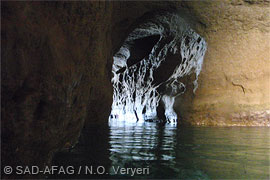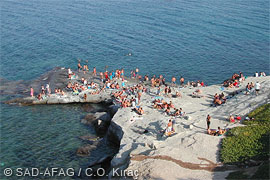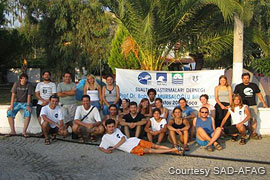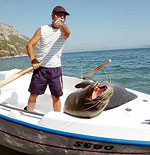

 |
||
 |
||
Vol. 12 (2): November 2009 |
||
Croatia / Greece / Madeira / Mauritania & Western Sahara / Turkey
Turkey
|
 |
 |
|
|
A view inside Ayıbalığı cave near Mordogan. SAD-AFAG researchers observed a juvenile seal inside the cave in autumn 2009. |
Crowds of local tourists swimming around the rocky shore just a few hundreds metres away from the Ayıbalığı breeding cave. |
In October 2009, it was learnt that a passenger and roll-on-roll-off ferryboat port is to be constructed on Arslan Cape near Karaburun town centre in monk seal habitat. Subsequently, the Environmental Impact Assessment (EIA) company requested SAD-AFAG’s opinion on the investment and its possible impact on the monk seal. After reviewing the project, SAD-AFAG emphasised the importance of habitat in and around Arslan Cape and proposed port construction in the already existing Saip fishing harbour, a couple of kilometres south of Karaburun town, in order to avoid destroying the pristine habitat area around Arslan Cape. – N. Ozan Veryeri, SAD-AFAG.
SAD-AFAG continued its monitoring activities on monk seals in the Foça SEPA with the continued approval and financial aid of EPASA (Environment Protection Agency for Special Areas) in 2009. The main monitoring activities included the collection of monk seal sightings and checking the previously identified monk seal caves (n=6) in the area. The monitoring was conducted between 31 July and 6 November 2009. As a result 63 monk seal sightings were collected out of 193 interviews among local people, fishermen and tourists. Though monk seal caves were visited 7 times each, none bore any sign of monk seal presence. The obvious decline of the monk seal population in the area had been attributed to increased marine traffic, human activities along the islands’ coasts and illegal fishing and over-fishing in the previous monitoring study by SAD-AFAG in 2008 [see Vessel carrying capacity studied in Foça SEPA, TMG 12 (1): June 2009]. Unfortunately, the same downgraded conditions prevail in the area. SAD-AFAG is planning to communicate to EPASA the need to take the necessary steps without delay to reverse the situation.
In addition, Turkish and English signposts were designed for EPASA. These will be located by the agency either on the lookout point of Foça town/and or the harbour, from where many people visit these sites. Furthermore, a draft protocol for the management of the Foça Municipality Rehabilitation Centre was prepared for EPASA, for consideration and approval among the public stakeholders, including the Ministry of Environment and Forestry, EPASA, Izmir Metropolitan Municipality, Foça Municipality and SAD-AFAG. – Elanur Yılmaz and Suna Tüzün, SAD-AFAG.
 |
|
|
|
The “Prof. Bahtiye Mursaloğlu Science Camp” took place in Foça between 20 and 30 August 2009, organized by SAD. Twenty-one students from various universities were selected to take part.
Both theoretical and practical lectures were given at the science camp in order to provide a higher level of knowledge and field survey ability to the students who are expected to participate in projects to be executed by SAD in the near future.
SAD-AFAG supported the science camp with its logistics already established in the area as a result of its previous projects and its operations in the Foça SEPA.
The camp programme featured both scientific and educational sections.
In the scientific section, three study groups were assigned different topics. These included fish diversity; monk seal habitat use and interaction of marine traffic and marine-coastal habitats; and sea urchin populations in the Foça SEPA. All groups collected their data either by skin diving or observations from the shore. The aim of these study groups was to introduce participants to the preparation and planning of scientific research and field work. This was followed by practical experience in collection and analysis of data, and the writing of a scientific paper. – Suna Tüzün, Nilay Akça and Elanur Yılmaz, SAD-AFAG.
As reported previously in TMG (UNDP-GEF supports integrated coastal and marine protected areas in Turkey], a new project was launched on 12 November 2009 in EPASA headquarters in Ankara entitled “Strengthening the protected area network of Turkey: catalyzing sustainability of marine and coastal protected areas”.
Funded jointly by the Turkish government and UNDP, the project will be implemented during the next 4-years under the responsibility of EPASA and in close collaboration with the other relevant governmental departments, universities and NGOs. It is without doubt a national scale project with a total budget of USD 6,500,000.
A kick-off meeting was held with a wide-ranging participation, featuring inaugural addresses by the MoEF Undersecretary, the EPASA Director and UNDP Permanent Representative, as well as technical presentations by Adriana Dinu UNDP-GEF Regional Consultant, Mehmet Menengiç, Head of the Research Department of EPASA and Dr. Harun Güçlüsoy, Project Manager.
The project is important in terms of solidifying Turkey’s marine and coastal zone protected areas and enhancing effective management of MPAs. Since Turkey has no specific legal framework for integrated marine and coastal zone protected areas, it is expected that the project will seek to develop the required legal basis and management structure for MPAs in Turkey.
Meanwhile, as indicated by EPASA during the inaugural meeting, the Gökova ICMM project, executed jointly by the Rubicon Foundation and SAD-AFAG, is being closely monitored and supported by the agency, on the basis that project results and experiences will help in developing best practice for this large-scale MPA initiative.
One of the targets of the initiative is to enlarge existing marine and coastal protected areas in Turkey from 240.000 ha. to 340.000 ha. (44%). Capacity enhancement of EPASA and effective MPA management will be implemented in the six selected areas: Foça SEPA, Gökova SEPA, Datça-Bozburun SEPA, Köyceğiz-Dalyan SEPA, Fethiye-Göcek SEPA and the Ayvalık Islands Nature Reserve. With the excepton of the Ayvalık Islands, all of the designated project areas are Important Monk Seal Sites in Turkey. SAD-AFAG will be transferring its relevant monk seal and coastal habitat knowledge and experience to EPASA during project implementation, with the aim of integrating conservation of this indicator species into this wide scale MPA project. – Cem O. Kıraç, SAD-AFAG.
 |
|
|
Posidonia sea grass meadows are under threat by marine traffic in Gökova Bay. The project aims to reduce the impact of mooring in Gökova SEPA. |
The BBI Matra funded “Gökova Integrated Coastal and Marine Management (ICMM) Planning” project continued its activities during the 2009 summer and autumn period. Posidonia distribution, underwater photography and filming, yacht traffic, monk seals and habitats, as well as marine and coastal bird studies were the main area of focus. Field studies revealed that the area holds very important habitats for Gökova's rich biological diversity. Observation records of monk seals (including multiple seal sightings of up to 3 individuals) and a pair of Osprey (Pandion haliaetus) with their fish catch are promising. Meanwhile, as part of the project, a ‘train-the-trainers’ seminar on integrated coastal and marine zones management planning was organized jointly by Rubicon, SAD-AFAG and EPASA. Christian Perennou from Tour du Valat Foundation (France), Mike Mannaart from EUCC (the Netherlands), Prof. A.C. Yalçıner from METU, Prof. A. Yücel from Muğla University and Sezer Göktan from EPASA provided seminars and lectures on several related topics during 4-6 October 2009 in Akyaka. Workshops were also held among participants on coastal zone management issues.
Seventy representatives from governmental agencies, local NGOs, coastal fisheries and universities participated. The basics and challenges of integrated marine and coastal zone management were discussed in detail. – Cem O. Kıraç, SAD-AFAG.
Badem, Turkey’s most famous monk seal, escaped her temporary summer captivity in Gökova Bay on 17 August, and quickly headed back to her old haunts, interacting with bathers and beach-goers along the busy coasts of Bodrum. Several bathers are reported to have sustained injuries, and monk seal conservation organisation SAD-AFAG again issued urgent appeals to members of the public not to swim or interact with the seal – both for their own sake and for Badem’s.
Rescued in December 2006 as an orphaned pup, Badem underwent rehabilitation in Foça, with AFAG drawing on expertise and nursing skills provided by the Zeehondencrèche Lenie ‘t Hart of the Netherlands. Regrettably, the seal became imprinted on her human carers during the 5-month process, a condition later exacerbated by swimmers’ and beachgoers’ demands for contact with her. She was released in April 2007.
 |
|
|
From the Hürriyet photo gallery. |
Turkish Daily Hürriyet published a photo gallery of the interactions between seal and bathers, showing some bathers visibly frightened as they escaped what had often become rough and dangerous play.
Human stupidity was on some occasions more than to blame for inciting or encouraging the seal; one man was pictured even throwing stones for the seal as if Badem were a pet dog.
SAD-AFAG has warned repeatedly that such interactions pose potentially serious risks of injury to bathers, as well as setting back any hope of recovery for Badem herself. The more such interactions continue, the more it reinforces such behaviour.
As it happened, Badem’s beach-frolicking summer came to an end on 27 August, when the runaway seal was recaptured by a SAD-AFAG team at Milas Ören in Gökova Bay; she was then returned to her temporary confinement in a large, specially-constructed sea pen at a fish farm in a less frequented part of the Bay.
The organisation, which undertook the intervention with its own limited resources, later reported that “instead of helping the team in charge, some tourists acted as obstacles.”
Coast Guard boats in Marmaris and Ören reported sightings of Badem to SAD-AFAG, though were apparently powerless to overcome the intense fascination that impelled beach-goers to swim and play with her.
Denizde Badem korkusu. Hürriyet, 26 Ağustos 2009.
“Let Badem does not hurt people nor she is hurt by people!” SAD-AFAG, 27 August 2009.
Badem undergoes veterinary treatment. 2009. The Monachus Guardian 12 (1): June 2009.
Copyright © 2009 The Monachus Guardian. All Rights Reserved |